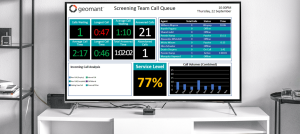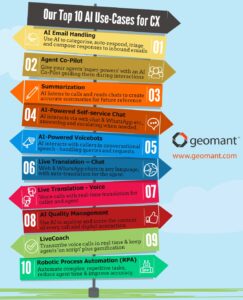Remote working has never been so popular (or accessible).
Though experts believe the world of work has been gradually shifting towards a more flexible future, the pandemic of 2020 accelerated this transition at an incredible level. By the end of 2020, 74% of professionals said they consider remote work to be the “new normal”. Perhaps more importantly, 97% of employees said they don’t want to return to the office full-time.
While social distancing and health concerns might have pushed us into the remote revolution to begin with, it’s the clear benefits of flexible working that is preventing brands from switching back. A flexible working environment today represents opportunities for better work/life balance, higher productivity levels, and better staff retention – all with lower total overhead costs.
The question is, can an environment so commonly associated with “in-office” work ever really convert to a truly remote strategy? Will contact centers be able to preserve and even increase their remote work efforts coming out of the pandemic?
Remote Working and the Contact Center
Contact centers were among the groups facing the biggest challenges during the shift to remote work in 2020. At first, contact center leaders panicked about maintaining productivity when managing huge teams of distributed employees. Concerns emerged around security and compliance, with teams questioning how they could keep customer data safe when communicating outside of the office.
Before the COVID outbreak, less than half of all contact centers in the US allowed remote work. Though these companies could see the benefits of things like reduced equipment costs and increased staffing flexibility, worries about transition to a new landscape held many organizations back. These organizations had concerns around security and accountability that made it difficult for them to offer remote work.
The events of the last 2 years have forced contact center operators to reconsider their staffing options much faster than expected. Fortunately, we’ve discovered during this time that with the right tools, the cloud-based contact center and remote agents can be just as effective (if not more-so), than the traditional environment.
The Benefits of Remote Work for the Contact Center
Despite initial concerns about a remote working future, countless studies have revealed positive changes following the transition. One study revealed that 45% of workers believe they’re more productive working from home, and 78% of employers agreed that they saw increased productivity from their workers during the lockdowns.
With 88% of organizations encouraging employees to work at home due to the pandemic, countless companies have had a chance to put remote working to the test. The response to the shift in working patterns has been incredible. Not only are employees more productive, but they’re more likely to stay with their employer if they have the option for remote work. Companies offering remote working strategies are seeing significantly lower turnover rates.
Some of the most significant benefits of a remote contact center environment today include:
- Access to a wider pool of talent: You can hire top employees from all over the world to offer the best quality of customer service or deliver amazing sales pitches.
- Scalability: Scaling your workforce to suit dips or peeks in demand is easier with a larger pool of candidates and the option to more quickly provision technology to employees.
- Convenient cloud technology: The cloud contact center of today can be as simple and accessible as today’s businesses choose, with access to everything from collaboration tools to reporting and analytics features.
- Better analytics: With everyone connected on the same digital environment, it’s much easier to track and measure both the customer and employee experience.
- Lower overhead costs: Fewer people in the office means less to pay for things like real-estate, electricity, and equipment maintenance.
Whether you love the new remote working norm or not, studies are beginning to show that future employers may not have a choice about offering flexible working. If you want the right talent, you need to offer remote working. Around 42% of employees say they would now quit their job on the spot if they were forced to return to the office full time.
How to Make Remote Work a Long-Term Reality
Though remote work has a range of benefits to offer, it presents challenges too. Companies worry about disconnected employees being unable to deliver a higher quality of work. Concerns about engagement levels or lower efficiency are often common among contact center leaders.
The key to discovering all the benefits of remote working without the negatives is building the right technology stack to serve your company’s needs. Remote working is a very real and valuable opportunity for the future of the contact center. However, like anything in today’s digitally transforming world, it needs to be approached with the right plan.
To make remote work a reality, you’ll need to consider the following:
Communication and collaboration
First, consider how your teams are going to stay connected in a remote world. Employees work best when they can work with colleagues to find better solutions to complex problems. Collaboration tools like Microsoft Teams, when used as the foundation of your digital contact center, ensure everyone in your team can stay on the same page.
Employee engagement and management
Keeping employees engaged and tracking interactions will be crucial in a remote environment. Today’s managers need a way to keep an eye on performance and productivity, through tools like dashboards and wallboards issuing valuable information in real-time. Similar tools can also be an excellent way to keep employees engaged. A dashboard tracking crucial metrics pushes employees to reach personal goals and outshine their colleagues.
Performance tracking and analytics
While real-time insights will help to enhance productivity and engagement among your teams, long-term analytics and reporting are also necessary to fully understand your users and customers. Gathering information about your employee engagement levels, the avenues your customers use for conversations and more should give you insight into the steps you can take to improve the CX strategy for your business long-term.
Security and compliance
A reliable and certified contact center provider can give companies the peace of mind they need to handle conversations between remote agents and customers in the cloud. Make sure your contact center provider has all the tools you need for an excellent security and privacy strategy. Solutions like Geomant Buzzeasy Contact Center for Microsoft Teams offers compliance recording features, so business leaders can appropriately manage compliance challenges.
Prioritize customization
A modern contact center will need to be customizable to suit the different kinds of businesses serving customers in this new world. This means businesses will need to find a platform that’s flexible enough to work with API connections and essential tools. Your contact center should be able to work with the tools you already use, like Microsoft Dynamics and Salesforce. The right provider will even be able to design unique customizations just for you.
User experience
Agents will work best in today’s remote world when they have contact center technology that’s intuitive, easy to use, and flexible. Remember to collect information as often as you can from your team members to find out what they like and dislike about your contact center technology. Building the contact center on top of a service your employees already feel comfortable with, like Microsoft Teams, can improve your chances of adoption.
Look for flexibility
As the remote contact center world continues to evolve, and customer expectations continue to change, businesses will need a contact center solution that can adapt to suit them. A scalable solution which offers access to innovative technology is a must-have. Businesses will need to look for CCaaS solutions which feature scalability, AI, and even self-service functionality.
Is Remote Working a Reality for Contact Centers?
Not so long ago, the idea of remote work would have been a difficult one for many contact center managers to consider. Issues with everything from security and compliance to productivity prevented a large percentage of businesses from moving to the cloud. Since the pandemic, companies have shifted into this new way of work faster than ever before, and it seems there’s no turning back for the majority.
While remote work has its challenges, the benefits far outweigh the risks if you know how to implement the right strategy. Building a contact center specifically designed to enable the future of remote work will ensure your employees can continue to be productive and engaged regardless of where in the world they might be located.
Work with a fully certified and proven contact center provider like Geomant to build the modern cloud-based contact center your teams need to thrive. You’ll be on your way to the remote working revolution in no time.











